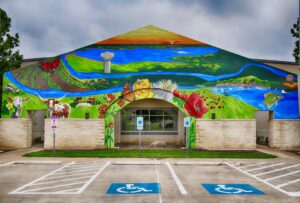“Watershed” by Sarah Blankenship

“Watershed” by Sarah Blankenship, 2024
Artist Statement:
The interconnectedness of our water systems! Whew, y’all sent me down a rabbit hole of research. There are so many elements to represent this, it is difficult to get it all in without making a mural look cluttered. I’ve tried to tell a story of how the water connects in Georgetown with as many positive images as possible, some of the negative ones aren’t as visually appealing. Happy to edit, remove, or edit as you prefer. The painted version will be a little more painterly. The details of what’s included:
In Georgetown, creating a healthy watershed and quality outdoor spaces is our goal for the well-being of our residents, flora, and fauna. The story starts at the top of the mural with Lake Georgetown. A spot of beauty, recreation, and a source of our drinking water. Two water towers are shown in the mural, one style from the east side and one from the west. Note the subtle cloud at the very top, a nod to the water cycle. From the lake, you see the San Gabriel River go back and forth to connect the North Fork and South Fork and of course Blue Hole! Fish are a sign of a healthy watershed. Bass, Crappie, Sunfish, and Catfish are found in lake Georgetown. A large Crappie is featured in the lower right corner jumping out of the water. A fisherman is catching a Bass. In the background are other wildlife enjoying the water, turtles, egrets, and ducks. Residents can be seen at Blue Hole swimming and enjoying the outdoors too.
On the left is a farm with plants growing using soil solarization. This heats the soil until temperatures are lethal to diseases, weeds, and some insects. Pesticides can contaminate soil which can runoff into the water. Lady beetles (Coccinellidae} are one insect that is helpful in controlling insect pests such as aphids without using poisons, hence the oversized ladybug image. There is a small scene of a family planting with a compost bin and water barrel nearby. At the bottom left are cows and goats grazing. The animals’ hooves help to break, aerate and mix up the soil. They also help to get rid of infestations of invasive plants. Invasive plants can reproduce and spread rapidly, taking space, nutrients, water, and light from other plants. If uncontrolled, they can damage parks, streams, and infrastructure. The mural shows the cows and goats grazing on invasive species from Georgetown’s Preferred, Controlled, and Prohibited Plant List. The cows are munching on Pampas Grass and Kudzu. The goats are eating Poison Ivy and Cat’s Claw Vine.
Around the arch is beautiful flora from Georgetown’s preferred plant list, along with a Georgetown must, the Poppy! From left to right they are as follows: Woolly Butterfly Bush, Rose ‘Grandma’s Yellow’, Passiflora ‘Passion Flower’, and Papaver rhoeas “Red Poppy”. The plants go down to the ground on either side of the arch where mulch is painted. Mulch helps cut down on erosion, reduces runoff by absorbing water and keeping pollutants out of the waterways. The Wooly has attracted a butterfly, and the Rose has attracted a bee, both are aid in pollination.









